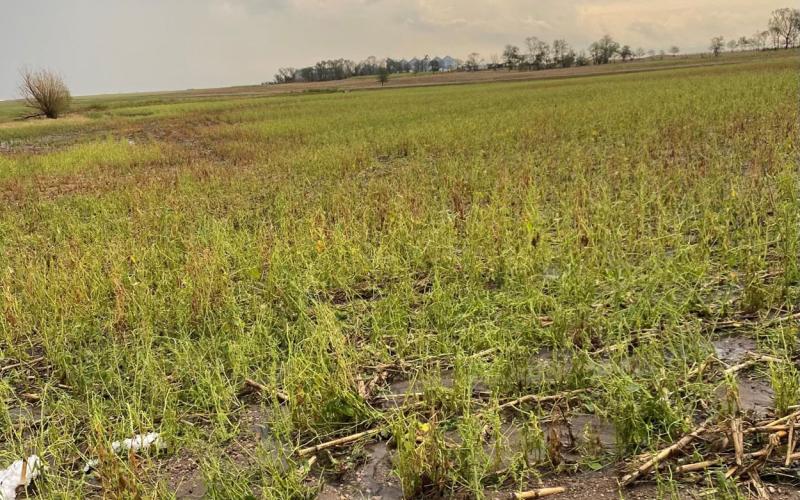Written by Mark Rosenberg, former SDSU Extension Agronomy - Weeds Field Specialist.
Numerous studies have been conducted over the last 40 years on soybean combine losses which show that yield loss can be as high as 15 percent. Although modern platform headers for soybean have reduced harvest loss to a minimum, do not expect it to be zero. Combines can be operated to reduce harvest loss without affecting the harvesting rate. Many adjustments will be a compromise between limiting harvest loss to acceptable levels and maintaining grain quality.
A goal for good field conditions is to keep harvest loss under one bushel per acre. The key to minimum loss is to adjust the combine for your crop conditions. Check losses periodically in the field, making the adjustments are well worth the time. Weather and other factors beyond our control create challenges at harvest. Accept the effects of adverse weather and adjust your equipment, speed and attitude accordingly.
Harvest loss results from a combination of gathering loss, pre-harvest loss, and machine loss. Gathering loss is the soybean harvest that does not get inside the combine, and accounts for around 80% of the total harvest loss. It is important to remember that ground speed, cutter bar conditions, and the location and speed of the pickup reel have an important influence on gathering loss.
Combine Setting and Adjustment
When setting the combine, soybean threshing needs to be just aggressive enough to remove beans from pods.
If beans are small, such as in a drought year, air flow may need to be reduced in the cleaning shoe and the openings in chaffer and sieve screens reduced to maintain air speed, yet allow beans to fall through. The threshing unit, cylinder-concave, or rotor-grate may also need to be adjusted for a smaller clearance. In the cleaning area, the cleaning sieve and/or the airflow may require adjustment.
If plant population is small and more pods will be close to the ground, it is essential to keep the cutter bar low. The front drum of the feeder should be low enough so that the chain just clears the floor of the feeder house. If plants are shorter, smaller clearances may be needed between the reel, cutter bar, auger, and the feed conveyor chain, to make sure stalks are feeding through the platform. Remember to pay attention to the height of the crop stubble left in the field. Crop stubble protects the soil by limiting exposure to wind and water erosion and by trapping snow in the fall, winter, and early spring.
Crop Residue Distribution
An even distribution of crop residue while harvesting is critical.
This is especially the case today where larger heads on combines mean more concentration of material into the narrow area of the machine. Large headers make the job tougher because they tend to concentrate material behind the machine. Grain platforms up to 30 feet wide collect residue into a 5-foot swath. Concentrated crop residues can insulate the soil's surface from the sun, reduce seed-to-soil contact, and make it tougher to plant in the spring. Getting that material spread back out can be difficult. Doing a good job of spreading chaff and stalks can minimize the amount of tillage needed to plant the crop next year. Set the combine so that straw and chaff spreaders or choppers operate properly and the combine distributes residue evenly.
Corn residue is usually heavy and most corn heads do a good job of chewing up the stalks and dropping them back in place. But the challenge is greater in the soybean harvest, where essentially the whole plant goes through the combine. Fine materials from any crop can end up in a windrow behind the combine because they cannot be thrown as far (due to air drag). Consider redirecting or increasing airflow from the combine's chopper to spread light particles further.
Estimating Harvest Loss
To get an estimate of your soybean harvest loss, check an area of ten square feet. Approximately 40 soybeans lost in this area will add up to one bushel per acre. Make loss determinations at several locations and calculate an average. If losses are greater in this area, machine adjustments need to be made. A goal for good field conditions is to keep losses under one bushel per acre. The key to minimum loss is to adjust the combine for the crop conditions. Check losses periodically in the field, making the adjustments are well worth the time.
To keep harvest loss to a minimum:
- Keep a level seedbed.
- Keep the cutter bar as close to the ground as possible.
- Don't drive too fast. Most combines today with platform headers are able to operate without problems at 3-4 miles per hour. If you use a row-crop header you can go a little bit faster. However, if you use a rigid platform you can't go as fast as with a platform header or a row-crop header.
- Use a reel speed about 10-25 percent faster than ground speed (up to 50 percent faster if the crop is lodged).
- Keep the reel axle 6 to 12 inches ahead of the cutter bar and as low as possible. Reel bats should leave beans just as they are cut and the reel depth should be just enough to control the beans.
- Complete the harvest as quickly as possible after beans reach 13 percent moisture content. Damage increases at lower moisture content (<10 percent) as well as at excessive moisture (> 14 percent).


